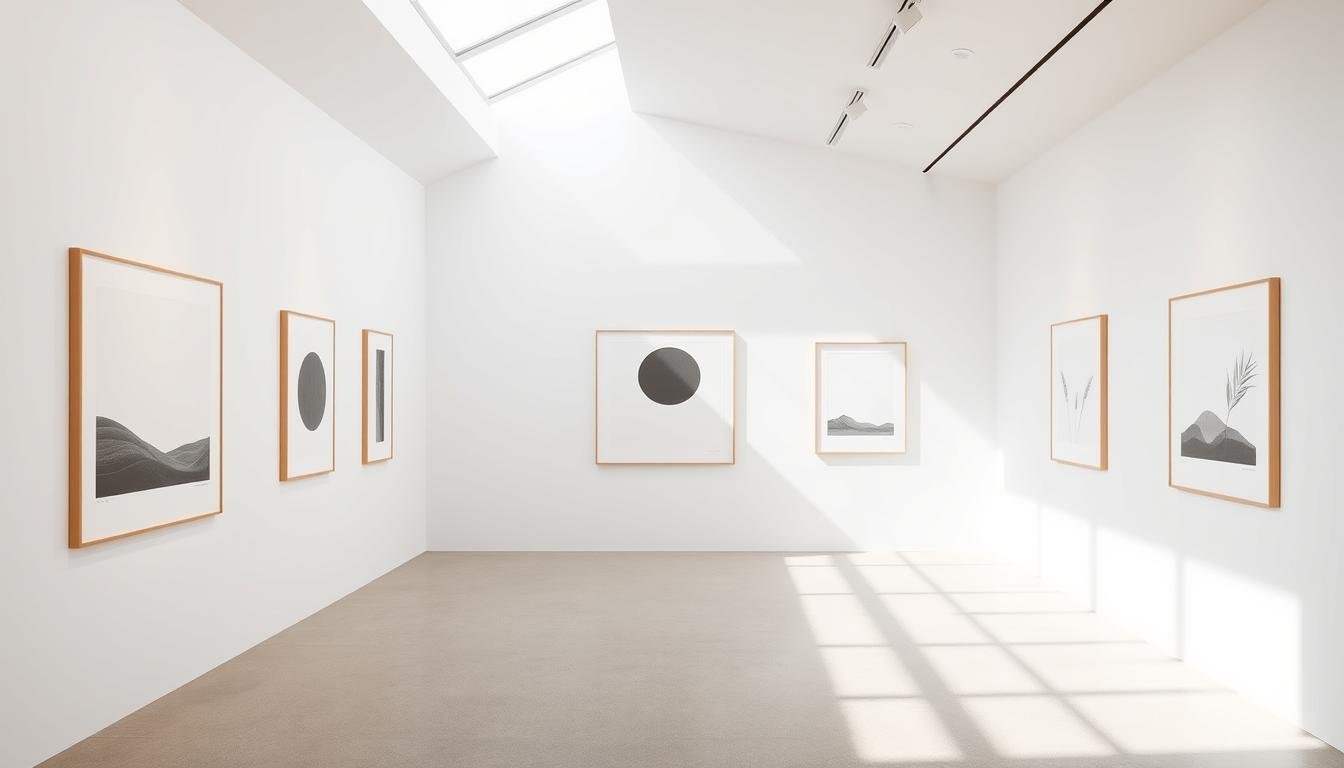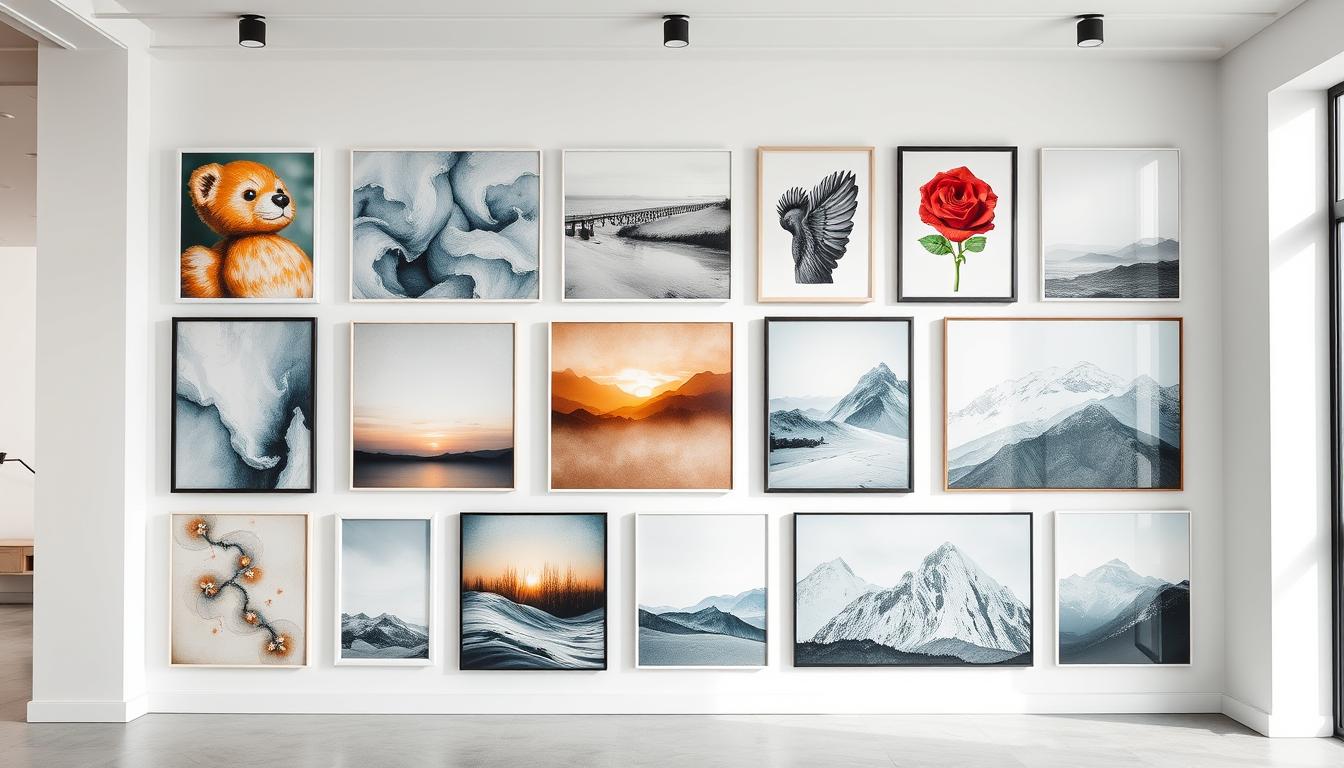Can a single line, a plain canvas, or a block of metal change how you feel in a room?
Minimalism began in the U.S. during the 1950s and 60s as a radical turn toward extreme abstraction. Artists like Carl Andre, Donald Judd, Dan Flavin, Sol LeWitt, and Robert Morris stripped work to geometry, industrial materials, and clear form.
This short guide shows how pared-down painting and sculpture still hold dramatic force in the present world. You will see how the idea that a painting is an object — as Frank Stella put it — shapes perception over time.
We move from the movement's roots to iconic works, shaped canvases, light pieces, and living-room tips for New York and beyond. Expect focused examples that highlight simplicity as a strategy, not a lack.

Key Takeaways
- Minimalist work centers on form, limited palette, and objecthood.
- Key artists turned industrial processes into quiet power.
- Simple choices—surface, edge, scale—create the drama.
- The movement informs design, architecture, and modern interiors.
- This guide pairs historical context with practical tips for displaying painting and sculpture.
What Minimal Art Is and Why “Less Is More” Matters Today
In the 1960s a group of artists stripped gesture and story away to focus on pure form.
Minimal Art crystallized in the United States as a clear break from Abstract Expressionism. Artists rejected expressive brushwork and embraced reduction. Works favored geometric shapes, hard edges, and industrial finishes.
The shift made abstraction literal: a painting or sculpture became an object to be seen as itself. Limited color and repeated forms create calm and immediate legibility. This clarity feels useful today as a counterpoint to visual overload.
Core traits and why they matter
- Geometric shapes and non-relational composition that avoid narrative balance.
- Seriality and repeated forms that emphasize order over emotion.
- Industrial materials and hard edges that remove traces of the hand.
"What you see is what you see."
New York in the 1960s was the hub where painting and sculpture met new processes. The movement’s logic—focus on form, surface, and direct perception—still shapes how we view painting and contemporary practice.
| Feature | Painting | Sculpture |
|---|---|---|
| Primary focus | Surface, edge, color field | Objecthood, serial placement |
| Materials | Canvas, industrial paint | Metal, Plexiglass, stone |
| Effect | Direct visual clarity | Spatial order and presence |
minimalist art examples
Start by treating each piece as a presence in the room rather than a story to decode.
How to evaluate: objecthood, form, color, and composition.
Ask first whether the work presents itself as an object and not a picture of something else. Donald Judd’s idea of “Specific Objects” helps: the piece should point to itself.
Notice form. Are shapes geometric and regular? Is the surface flat or textured? Check if the arrangement feels balanced across the wall or floor.
Look at color choices. A limited palette or monochrome often reads as spatial and optical, not expressive. Examine composition: non-relational layouts avoid a single focal point so each part holds equal weight.
- Watch lines and edges: crisp edges suggest a manufactured method.
- Consider space: how does the work change your movement in the room?
- Compare works side by side to see how tiny shifts in color or edge alter perception.
| Trait | What to look for | Why it matters |
|---|---|---|
| Objecthood | Stand-alone presence | Focus on the work itself |
| Form | Geometric shapes, flat surfaces | Creates clear visual logic |
| Finish | Industrial paint or matte | Affects reflection and distance |
Finally, mind the artist’s practice and approach. Some follow rules and systems; others keep a personal method. Both routes enrich how you read painting and sculpture in this field.
Iconic Minimalist Paintings: Lines, Grids, and Color Fields
These paintings teach readers how shape, edge, and color can define a work’s presence.
Frank Stella’s Black Paintings use tight black bands and the raw canvas edge to assert that a painting exists as an object. His phrase,
"What you see is what you see."
anchors a practice that moved abstraction toward literal presence in the United States and New York in the 1960s.
Agnes Martin’s meditative grids
In Friendship Martin carves faint grids and applies gold leaf to make a calm, charged field. Her work shows that emotion and reduction can coexist.
Ellsworth Kelly’s panels and color
Kelly’s Red Yellow Blue II treats color as structure. Multi-panel sequencing and shaped canvases collapse shape and support into one unified object.
Jo Baer and framed fields
Baer wraps white interiors with dark bands to reject pictorial depth and keep focus on surface and edge.
Robert Ryman’s white-on-white study
Ryman makes painting a question about stroke, finish, and how paint meets the square support.
| Artist | Key feature | Why it matters |
|---|---|---|
| Frank Stella | Black stripes, raw edges | Painting as objecthood |
| Agnes Martin | Subtle grids, gold leaf | Meditative field + feeling |
| Ellsworth Kelly | Monochrome panels | Color as structure |
| Jo Baer | Dark framed bands | Hard-edge clarity |
| Robert Ryman | White-on-white surface | Focus on practice and finish |
Compare careers and decisions about edge, panel, and scale to see how each work shaped the movement. For a wider survey of focused painting, see the best minimalist painting overview.
Shaped Canvases and the “Object”: When Paintings Become Things
Shaped canvases mark a moment when painting stops pretending to be a window and becomes a thing in itself.
Form and edge take charge: the support is no longer neutral. These works ask to be read as an object on the wall, not as an image to decode.
Ellsworth Kelly’s Yellow Piece and the shaped canvas breakthrough
ellsworth kelly collapsed image and support with Yellow Piece (1966). The canvas shape is the work’s form, painted a single hue so the surface reads as a literal presence.
Frank Stella’s Harran II and the evolution of form
Stella’s Harran II joins cut shapes—arcs, squares, and arched triangles—into a single reading. Bright color ties the parts so the painting reads like one unified object.
Donald Judd’s “Specific Objects” and non-relational composition
donald judd argued that some objects are neither painting nor sculpture but specific in themselves. His essay reframed how artists pursued clarity, repetition, and non-relational layout.
- Color acts as structure: it holds shapes together instead of illustrating a subject.
- Series logic: repeating forms lets small shifts change perception across multiple works.
- Viewing tip: stand slightly off-center to feel how edges project into the room.

| Work | Key move | Why it matters |
|---|---|---|
| Yellow Piece | Canvas as form | Painting becomes thing |
| Harran II | Interlocking shapes | Unified optical rhythm |
| Specific Objects | Object-based logic | Clears boundary of painting/sculpture |
These shifts reshaped New York studios and the course of minimalism, pushing artists to test how shape, color, and repeatability make works read as complete, self-contained objects.
Minimalist Sculpture: Cubes, Planes, and Industrial Materials
Artists translated the clarity of pared forms into three dimensions, changing how viewers move.
Donald Judd’s stacks use aluminum and colored Plexiglass modules that alternate opaque and translucent faces. These objects keep a steady form while creating shifting spatial effects as you walk past.
Robert Morris makes mirrored boxes that force reflection. Untitled (Mirrored Cubes) pulls the room—and you—into the work, so the viewer becomes part of the piece.
Carl Andre’s floor pieces of copper, brick, or stone sit low and planar. Installed in situ, they change how people step and gather, turning the gallery floor into an element of the work.
Richard Serra’s weatherproof steel plates bend and curve through space. His massive forms choreograph movement and raise awareness of scale, weight, and axis.
Anne Truitt’s painted wooden columns bring quiet order. Her upright forms use restrained color to make sculpture feel intimate at human scale.
- Industrial characteristics: clean edges, repeatable units, and direct materials.
- Light matters: mirrors, Plexiglass, and sheen alter perception across conditions.
- Many of these works originated in New York and across the United States, signaling a move away from Abstract Expressionism toward literal objects.
| Artist | Material | Characteristic |
|---|---|---|
| Donald Judd | Aluminum, Plexiglass | Modular stacks that shape space |
| Robert Morris | Mirrored boxes | Reflection folds viewer into the work |
| Carl Andre | Copper, brick, stone | Floor planes that alter movement |
| Richard Serra | Weatherproof steel | Massive curves that choreograph walking |
| Anne Truitt | Painted wood | Columns with calm color and presence |
Light, Space, and Installation: Minimalism Beyond the Pedestal
When light, yarn, and instruction replace pedestal and canvas, the viewer becomes a moving measure of the work.
These installations expand how a room reads. They make architecture active and ask you to move to complete the piece.

Dan Flavin’s fluorescent light works and spatial color
Flavin used ready-made fluorescent fixtures to treat light as material. His tubes wash walls with color and make the surrounding space feel sculpted.
"Untitled (in honor of Harold Joachim) 3" demonstrates how light can redefine a room.
Sol LeWitt’s wall drawings and serial systems
LeWitt wrote instructions so others could execute a series of bands and lines. The result: repeatable installations that adapt to any wall.
Fred Sandback’s lines in space: yarn-defined geometry
Sandback stretched acrylic yarn to mark edges. A few taut lines can imply full volumes and change how you step through space.
Judy Chicago’s Rainbow Pickett and minimalist feminism
Chicago’s six leaning trapezoids use color and form to reshape circulation. The work links room-scaled patterning to broader cultural concerns.
- These pieces push shapes and edges off the wall and into the room.
- They show that light, wall, and line can be as potent as painting or sculpture.
- Visit in person: shifting viewpoints make the work complete.
| Artist | Material | Effect |
|---|---|---|
| Dan Flavin | Fluorescent light | Ambient color that defines space |
| Sol LeWitt | Instructions/wall | Serial, repeatable systems |
| Fred Sandback | Acrylic yarn | Lines that imply volumes |
| Judy Chicago | Painted forms | Room-scale color and pattern |
Abstraction, Order, and the Hard Edge: Formal Traits to Spot
Look closely: the quiet logic in these works rests on order more than gesture.
Non-relational composition and seriality vs. expressionism
Non-relational composition means each part coexists without a single focal hierarchy. Parts hold equal weight and create a calm order that resists expressionist drama.
Serial methods repeat a unit across a series, letting tiny shifts become the subject. Comparing two works in a sequence shows how small changes change the whole.
Hard edges that read as manufactured precision
Hard edges put lines and color fields side by side with crisp separations. The result feels mechanical: the artist’s hand is hidden and finish reads like industry.
To view these characteristics, scan edges, joints, and seams. They reveal the piece’s internal logic and the artist’s planning approach.
| Trait | What to look for | Why it matters |
|---|---|---|
| Non-relational composition | Equal parts, no central focus | Creates calm visual order |
| Hard edge | Crisp joins between colors | Removes gesture, highlights surface |
| Seriality | Repeating units across works | Isolates subtle variation |
"These works reference only themselves."
Even in New York’s charged scene, many artists chose restraint. That choice sharpens attention to structure, material, and real-time perception of abstract art.
Minimalism’s Dialogues: From Zen and Taoism to New York’s 1960s Movement
Quiet philosophies and city studios fed a new visual language that balanced inward calm with urban rigor.
Agnes Martin’s inward gaze
Agnes Martin read the Tao Te Ching and kept a meditation practice that shaped her grids.
Her thin lines and pale bands act like breaths on a page. They offer serenity and clarity that bridge Abstract Expressionism and minimalism.
Martin’s canvases feel like a place to pause. The work asks viewers to slow down and enter a private, reflective field.
New York and the rise of a movement
In New York during the 1960s, artists formed a clearer definition of the art movement.
Figures such as Donald Judd, Sol LeWitt, and Robert Morris promoted objects and structures that refer only to themselves.
They moved away from narrative and toward presence. Sculpture and wall pieces became literal, not illusionistic, parts of the world.
"These works reference only themselves."
- Martin’s grids show inward poise rather than raw expression.
- New York galleries sped the spread of these ideas across the art world.
- Viewer position and perception activate otherwise simple forms.
| Topic | How it shows | Why it matters |
|---|---|---|
| Spiritual influence | Calm grids and measured lines | Invites quiet attention |
| Urban context | New York studios and galleries | Turned practice into an art movement |
| Object focus | Self-referential sculpture | Redefined what a work can be |
Contemporary Continuations: Updating Minimalist Language
Today’s practitioners keep reduction’s rules but push surfaces, printing, and perception into fresh territory.
Brent Hallard’s precision and personal language
Brent Hallard works with clean color fields and exact geometry. His paintings favor sharp shapes and measured edges. The result feels both rigorous and quietly personal.
Richard Caldicott’s process-driven objects and surfaces
Richard Caldicott blends drawing, photography, and small-scale sculpture. His process-led approach turns prints and handmade marks into wall-based objects that interact with space.
Mary Corse’s glass microspheres and changing light
Mary Corse uses glass microspheres in acrylic so works shift with viewing angle and light. These paintings reward time and movement: the surface looks different as you change position.
Why it matters: contemporary artists borrow the older logic of reduction while updating materials and tools. Small choices—edge crispness, substrate, reflectivity—control how a work reads. Many careers cross media, choosing the medium that best serves an exact idea.
| Artist | Method | Key effect |
|---|---|---|
| Brent Hallard | Traditional media, hard edges | Precision + personal language |
| Richard Caldicott | Hybrid printing and objects | Process-driven surfaces that alter space |
| Mary Corse | Microspheres in acrylic | Light-sensitive surfaces that change with time |
Applying Minimalist Art in Modern Interiors
Choose a single, strong wall work to anchor a room and let every other element respond to its scale and tone.
Clean lines, geometric shapes, and calm compositions in design
Clean lines and basic forms make a space feel ordered and calm. Geometric shapes translate easily across furnishings, rugs, and lighting.
Limit palettes to two or three tones so paintings and furniture read together. The result: a coherent room where each form supports simplicity and order.
Leave breathing room around works. Negative space helps edges and planes read clearly and keeps sightlines open.
Selecting focal artworks to enhance space, light, and order
Pick one strong artwork as the focal anchor, then build the palette and materials around it. A single panel can organize an open plan or calm a cozy corner.
Consider color as a tool: warm fields complement wood and stone; cool fields suit concrete and steel. Surface finish matters—matte absorbs light, reflective surfaces shift with daylight.
- Balance wall pieces with a floor sculpture to guide movement without blocking views.
- Scale works to the room: large panels for open plans, modest paintings for intimate zones.
- Test placement across the day; light changes how edges, forms, and color appear.
"Restraint often reads richer than excess."
| Tip | Why it works | Use |
|---|---|---|
| One focal painting | Organizes visual weight | Entry, living wall |
| Negative space | Makes edges crisp | Gallery wall, above sofa |
| Surface finish | Interacts with light | South-facing rooms |
Conclusion
Clean decisions, in painting and sculpture, sharpen how a room, light, and movement read together.
Minimalism began in the United States and New York and changed how viewers meet works. The movement moved painting toward objecthood, then into sculpture and installations that use light and space.
Artists from agnes martin and ellsworth kelly to dan flavin proved that a focused series or a single finish can reward time and close looking. Edges, surface, and scale reveal small shifts with each visit.
Use the evaluation tips here to approach any painting or sculpture with curiosity. Visit museums and galleries to see how these strategies still shape contemporary abstract art in the world.
Enhance Your Space with Unique Modern Masterpieces by Chiara Rossetti
Are you inspired by the innovative mediums and conceptual depth highlighted in our exploration of contemporary art? You’re not alone! Today’s art enthusiasts are seeking cultural relevance and emotional connections in their artwork. However, finding pieces that resonate with modern themes and fit your unique style can be a challenge. That’s where we come in!
At Rossetti Art, we specialize in canvas prints, original paintings, and modern sculptures that celebrate the spirit of now. Each piece created by Chiara Rossetti brings a personal touch that connects deeply with current social narratives—just like the modern masterpieces discussed in the article. Don’t miss out on the chance to elevate your home decor with breathtaking artwork that speaks to your values and aesthetic. Explore our collection today and find your perfect piece! Act now, and transform your space into a gallery of inspiration!
FAQ
What defines minimal art and why did it emerge from Abstract Expressionism?
Minimal art rose in the 1960s as a reaction to Abstract Expressionism’s emotion and gesture. Artists like Donald Judd, Frank Stella, and Agnes Martin emphasized pared-down forms, industrial materials, and an objective, non-relational approach. The goal was clarity: simple shapes, repeated modules, and precise surfaces that foreground the object itself rather than painterly drama.
Which artists best illustrate this pared-back approach?
Key practitioners include Donald Judd for his “specific objects” and metal stacks, Frank Stella for his shaped canvases and Black Paintings, Ellsworth Kelly for bold monochrome panels, Agnes Martin for meditative grids, Dan Flavin for fluorescent installations, Carl Andre for floor-based arrangements, and Robert Ryman for white-on-white surface studies.
What visual traits should I look for when evaluating works?
Look for geometric shapes, hard edges, serial repetition, limited color palettes, and an emphasis on objecthood. Consider composition, surface treatment, and how the piece occupies space. Works often read as manufactured or modular rather than as expressive gestures.
How do shaped canvases change the way we read painting?
Shaped canvases, as used by Ellsworth Kelly and Frank Stella, collapse the boundary between painting and object. By altering the frame or silhouette, these works become physical forms that insist on their presence in space, shifting attention from illusion to actual shape and volume.
What role do industrial materials play in this practice?
Industrial media—aluminum, Plexiglass, fluorescent tubing, bricks, and commercially primed surfaces—underscore a non-handmade aesthetic. They create precise edges, uniform color fields, and durable, repeatable modules that reject gestural trace and highlight fabrication.
How does light and installation expand the language?
Artists such as Dan Flavin and Fred Sandback used light and minimal elements to shape perception of space. Fluorescent tubes or slender yarns define planes, change atmosphere, and invite viewers to experience volume, color bleed, and spatial relationships rather than just surface imagery.
Are there spiritual or philosophical influences behind the work?
Yes. Some artists drew on Zen, Taoist ideas, or spiritual introspection—Agnes Martin’s grids often reflect inward calm and meditative order. At the same time, others prioritized formal clarity and industrial logic without overt spiritual framing.
How did New York shape the movement’s development?
New York provided galleries, critics, and a network of museums that championed reductive practice. The city’s 1960s scene fostered debates around objecthood, seriality, and the boundaries between sculpture and painting, helping define what the movement became.
What distinguishes minimal sculptural work from traditional sculpture?
Minimal sculpture often uses simple, repeated units and industrial fabrication to create non-hierarchical forms. Works by Donald Judd, Carl Andre, and Richard Serra emphasize scale, material presence, and spatial placement over figurative or narrative content.
How do contemporary artists continue this tradition?
Contemporary practitioners adapt minimalist vocabulary through new processes and materials. Artists like Mary Corse explore light with glass microspheres, while others emphasize surface systems or precision geometry, updating the language while keeping core principles of reduction and clarity.
Can these works fit in modern interiors, and how should they be displayed?
Yes. Simple, well-lit spaces suit these pieces. Use clean walls, logical sightlines, and consider scale—large works need room to breathe. Choose a single focal work or a small series to create calm, balanced compositions that enhance light and order in a space.
How does seriality function within this practice?
Seriality—repeating modules or variations on a theme—creates rhythm and structure. It removes anecdote and emphasizes system, encouraging viewers to compare units and perceive subtle shifts in color, proportion, or placement across the series.
Where can I see landmark works in person?
Major museums house canonical pieces: the Museum of Modern Art and the Whitney Museum in New York, the Art Institute of Chicago, Tate Modern in London, and the Menil Collection in Houston all hold significant works by Judd, Stella, Kelly, Martin, and Flavin.
How do color and limited palettes function in these pieces?
Restricted palettes focus attention on form, edge, and surface. Strong single colors or small combinations create visual tension and clarity. Ellsworth Kelly’s monochromes and Agnes Martin’s subtle tones show how limited color choices can produce powerful presence.
What questions should a viewer ask when encountering a work?
Ask: How does this object occupy space? Are edges and surfaces manufactured or handworked? Does repetition suggest a system? How does color interact with light? These queries help reveal intent and the work’s formal logic.







Leave a comment
This site is protected by hCaptcha and the hCaptcha Privacy Policy and Terms of Service apply.